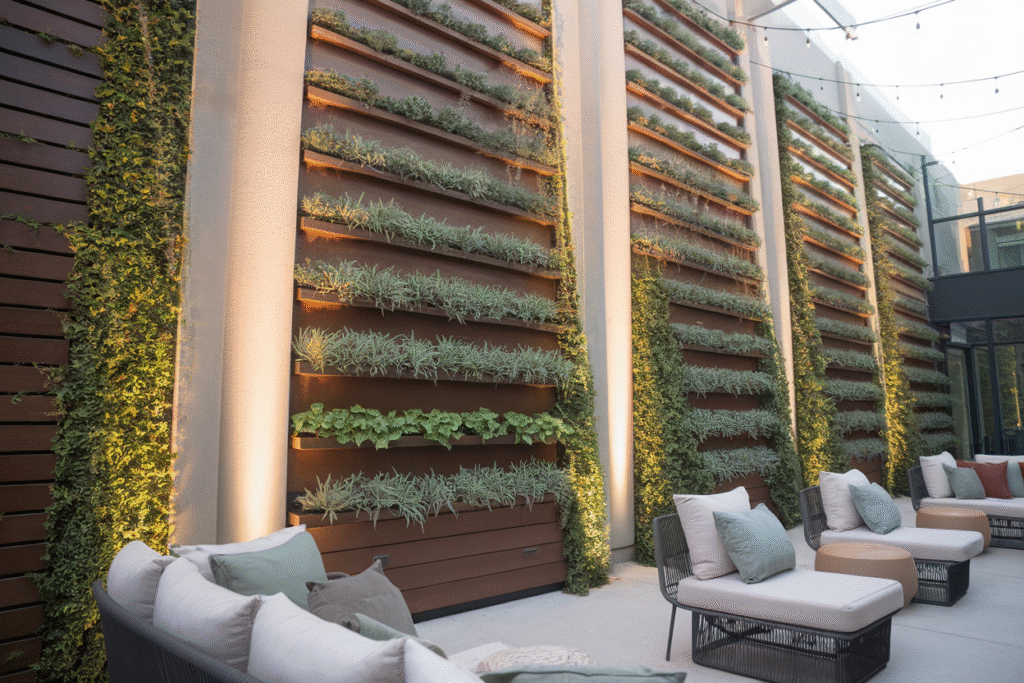Designing a beautiful outdoor area can feel overwhelming when space is limited, but DIY outdoor garden walls vertical gardens make it possible to create something lush and inspiring without needing a big backyard. These living walls turn any space into a green sanctuary that feels refreshing and modern. In this article, you will learn how to design, build, and style your own vertical garden and discover why these smart, space saving walls are one of the most popular decor trends for 2025.
Why DIY Outdoor Garden Walls Vertical Gardens Are Perfect for 2025
As people continue to spend more time at home, outdoor spaces have become just as important as indoor ones. Vertical gardens match the direction of 2025 design trends because they support mindful living, natural textures, wellness inspired design, and sustainable solutions. Homeowners want greenery that feels intentional and calming, and DIY outdoor garden walls vertical gardens offer that soothing mix of beauty and function.
Vertical walls also work beautifully with modern architecture which leans toward clean lines and minimal clutter. They give homes a soft, organic layer that balances hard surfaces like metal, stone, or wood. With rising interest in biophilic design, homeowners are intentionally adding plants that support air quality, mood improvement, and sensory comfort. This makes vertical gardens one of the most relevant decor choices for 2025.
Top Benefits of DIY Outdoor Garden Walls Vertical Gardens
Save Space While Adding Greenery
One of the biggest benefits is how much greenery you can enjoy without sacrificing usable space. Vertical gardens climb upward instead of spreading outward, which makes them ideal for small backyards, apartments, narrow patios, and balconies. For example, a tiny 4 foot wide patio can hold a full herb garden simply by using a trellis or modular plant pockets.
Improve Outdoor Aesthetics Instantly
Vertical gardens are visual showstoppers. They create a dramatic backdrop for seating areas, dining nooks, or outdoor lounges. Imagine sitting under string lights while a full green wall grows behind you. Your space looks curated and elevated without needing expensive furniture or renovations.
Support Eco Friendly Living
Plants naturally improve air quality, support pollinators, and help control heat. Adding vertical greenery reduces the harshness of concrete or brick and encourages a sustainable lifestyle. Many homeowners grow vegetables, herbs, and berries on their garden walls to reduce grocery waste and add convenience.
Increase Home Value and Curb Appeal
A beautifully designed vertical wall instantly makes your outdoor area look more expensive. Real estate experts note that outdoor living upgrades can influence buyer interest and perceived home value. A vertical garden can refresh an older space and bring a modern, stylish look that feels high end.
Step by Step Guide to DIY Outdoor Garden Walls Vertical Gardens
- Choose your location
Pick a spot with adequate sunlight for the plants you want to grow. South facing walls offer the most light, while east facing gives gentle morning sun. Make sure the wall can handle moisture or add a protective backing board. - Select your vertical structure
Popular choices include wooden pallets, trellises, metal grids, hanging pockets, modular planters, or even built in shelving systems. Choose something that matches your outdoor style and fits your plant needs. - Prepare your plants
Select plants based on sunlight, climate, and the overall vibe you want. Ferns, ivy, succulents, herbs, flowering vines, and compact vegetables all work well. Mix heights and leaf textures for depth and interest. - Set up soil and irrigation
Use lightweight potting mix to avoid weighing down the structure. Add an irrigation line or choose self watering planters to keep maintenance easy. Vertical gardens dry out faster, so consistent moisture is important. - Install your wall frame
Secure your structure firmly onto the wall or fence. Use appropriate anchors or screws to prevent sagging. Check that the base is level so plants grow straight. - Arrange your plants
Start with larger or trailing plants at the bottom and lighter plants near the top. Work in layers so the wall looks balanced and full. Step back frequently to make sure the design feels harmonious. - Maintain your garden wall
Trim overgrown sections, add fresh soil as needed, and check for pests. Water your plants more often during warmer months. With regular care, your wall will stay lush and clean.
Designer Tips to Elevate DIY Outdoor Garden Walls Vertical Gardens
To style your vertical garden like a designer, think of it as an extension of your outdoor living space. Use planter colors that match your furniture, such as matte black for modern patios or warm terracotta for rustic spaces. Add outdoor lights to highlight your greenery at dusk. For 2025, designers love mixing organic textures with soft lighting to create cozy zones for relaxing or entertaining.
You can also incorporate layered styling by placing a bench, lanterns, or a small bistro table near the garden wall. This brings the space together and makes your vertical garden feel like a purposeful backdrop instead of an isolated feature. Another tip is to mix edible plants with decorative plants. Herbs like rosemary or basil add fragrance, while trailing ivy or lavender brings softness. This combination creates an outdoor wall that looks beautiful and serves practical value at the same time.
7 Trending Designs in 2025 for DIY Outdoor Garden Walls Vertical Gardens
1. Modern Wooden Slat Garden Wall
The modern wooden slat garden wall has become one of the most loved trends because it blends clean lines with warm, natural textures. The horizontal wooden slats look almost like a piece of outdoor artwork and the sleek black planters create a beautiful contrast that feels modern and calm at the same time. When the greenery starts to spill over the edges, the whole wall looks soft and inviting which makes it perfect for minimalist patios or small seating areas. The plants seem to float against the wooden background which gives the entire wall a designer style without needing anything complicated.
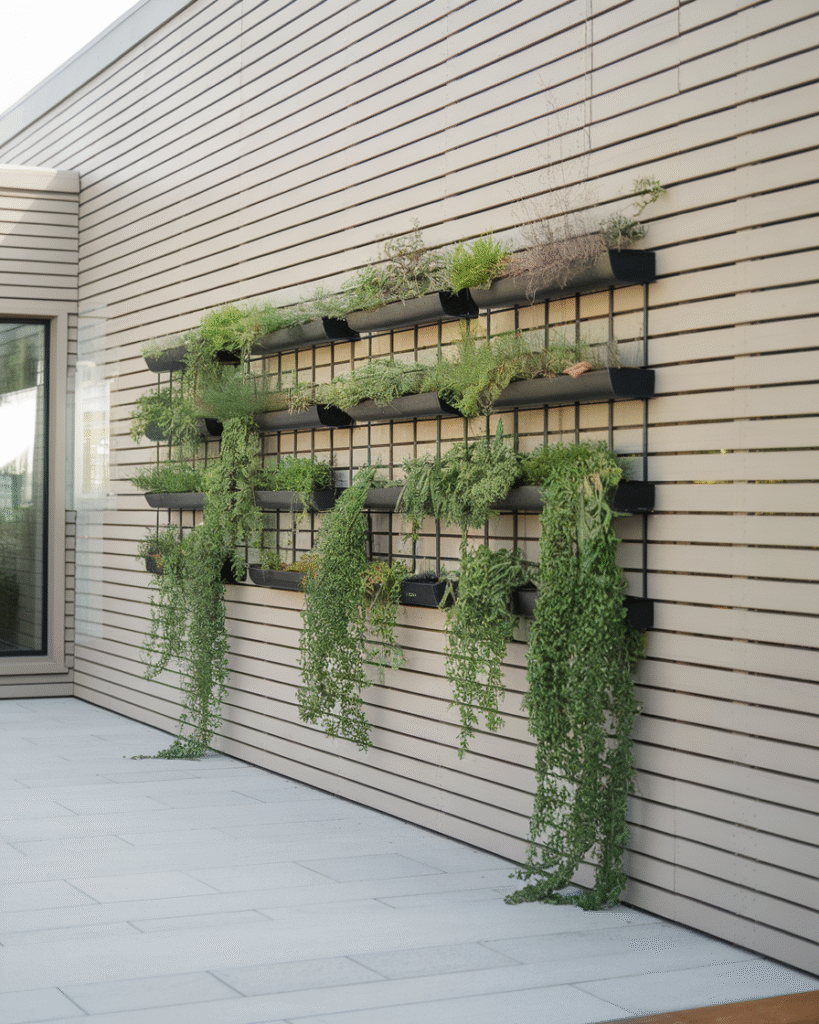
2. Rustic Farmhouse Garden Wall With Reclaimed Wood
If you love cozy and character filled spaces, the rustic farmhouse vertical garden might speak to you the most. This trend uses reclaimed barn wood or weathered boards which immediately gives the wall a nostalgic and warm feeling. Many people pair the wood with old fashioned metal buckets or small galvanized containers which look charming once you fill them with colorful blooms like pansies, petunias, or ivy. The mix of aged wood and vibrant plants brings a very welcoming and homey touch to any outdoor corner which is why this trend keeps growing.

3. Lush Tropical Green Wall
The lush tropical green wall is ideal for anyone who wants their backyard or balcony to feel like a peaceful getaway. This trend uses large, leafy plants such as ferns, monsteras, philodendrons, and tropical vines. The key is layering the plants so they look dense and full rather than spaced out. The rich greens create a soothing environment which feels almost like stepping into a small private resort. If you want a dramatic wall that instantly makes your space feel more refreshing, this style is perfect.
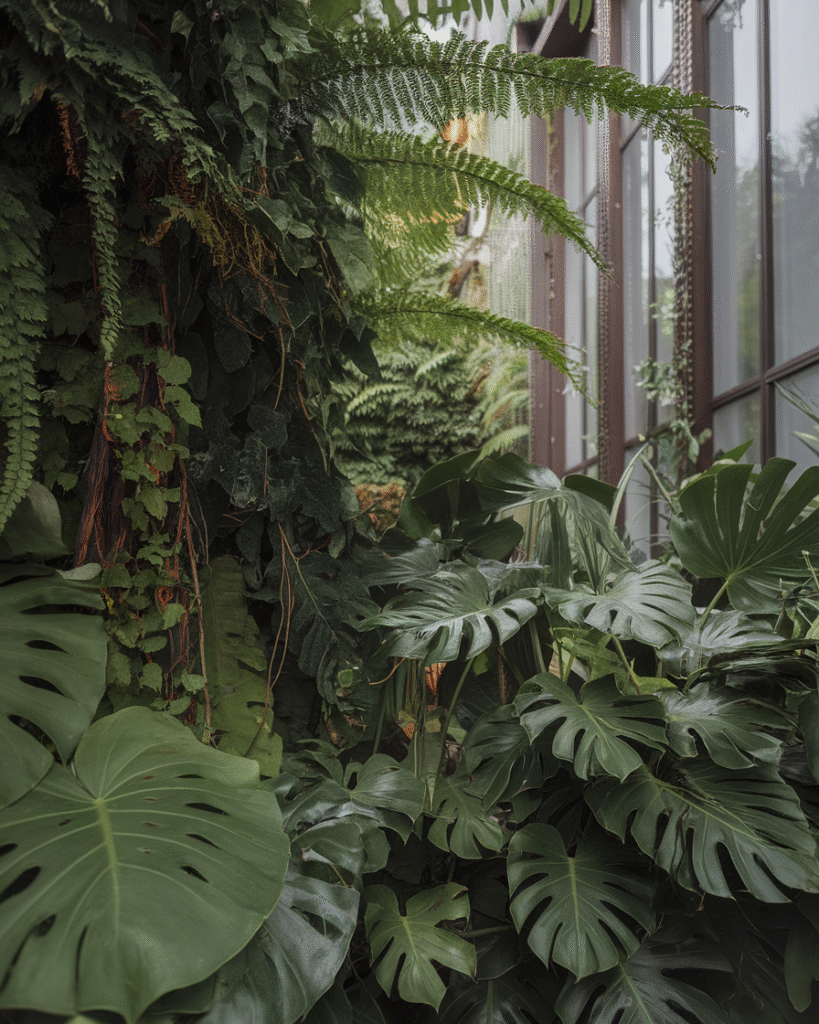
4. Industrial Metal Grid Garden Wall
The industrial metal grid wall is a strong favorite for small modern balconies or urban homes because it feels structured and stylish at the same time. The wall usually starts with a black or silver metal grid which acts like a giant frame. Small concrete or metal planters are clipped to the grid which creates a clean, organized look. The combination of metal and greenery gives a cool city inspired edge that feels modern without feeling cold. It is simple, functional, and perfect if you like a minimalist style.

5. Herb and Vegetable Vertical Kitchen Wall
This trend is one of the most practical and honestly one of the most fun to create. Many homeowners are turning their vertical garden walls into mini outdoor kitchens where basil, mint, cherry tomatoes, lettuce, and peppers grow right outside the door. The wall becomes a living pantry that smells fresh and looks beautiful which makes outdoor cooking feel much more enjoyable. It also helps reduce grocery waste since you can pick exactly what you need.
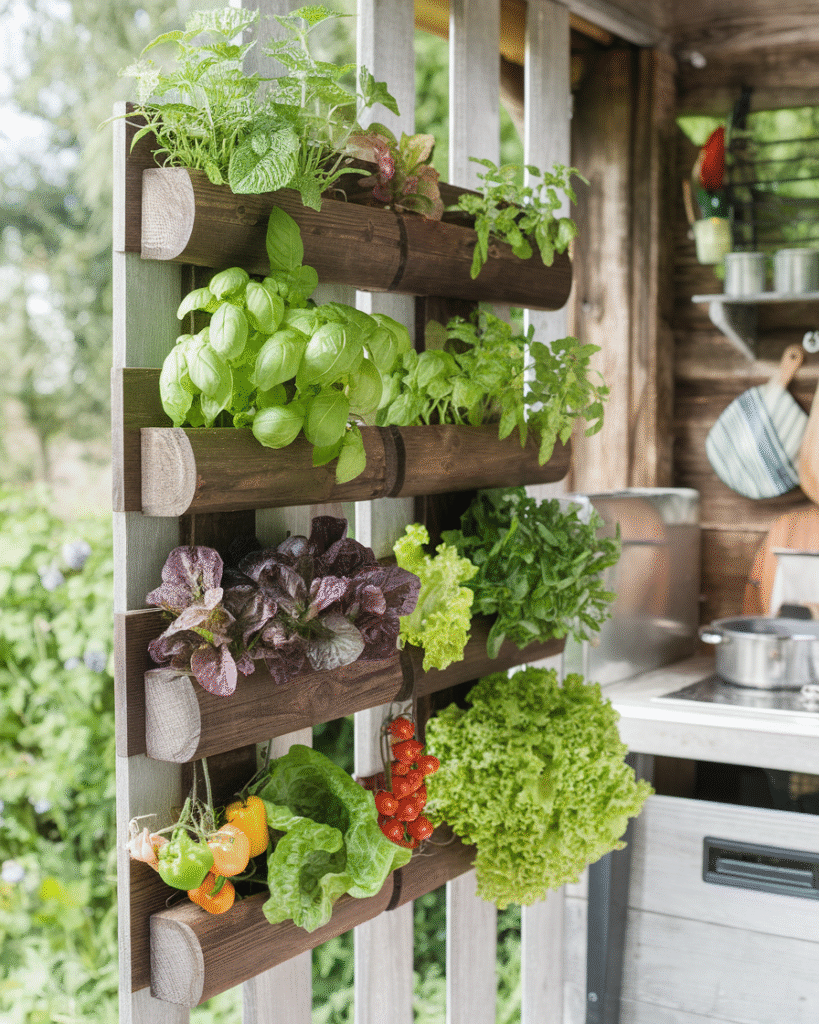
6. Boho Hanging Pocket Garden Wall
The boho hanging pocket garden wall is perfect for anyone who loves a relaxed and artsy outdoor look. This design uses hanging pockets made of canvas or macrame which instantly adds a soft and creative touch. When you fill the pockets with trailing plants like pothos or string of pearls, the wall takes on a dreamy and free flowing look. It pairs beautifully with outdoor rugs, pillows, lanterns, and cozy lounge seating which makes it one of the easiest ways to create a warm, inviting corner outside.

7. Living Moss and Stone Wall
If you are trying to create a calm and meditative outdoor space, the living moss and stone wall is a wonderful option. This trend brings the feeling of a nature spa into your backyard with rich green moss, tiny ferns, and softly placed stones. It works best in shaded areas where the moss stays naturally hydrated. The overall look is peaceful, earthy, and grounding which makes it perfect for reading corners, quiet patios, or small garden hideaways.
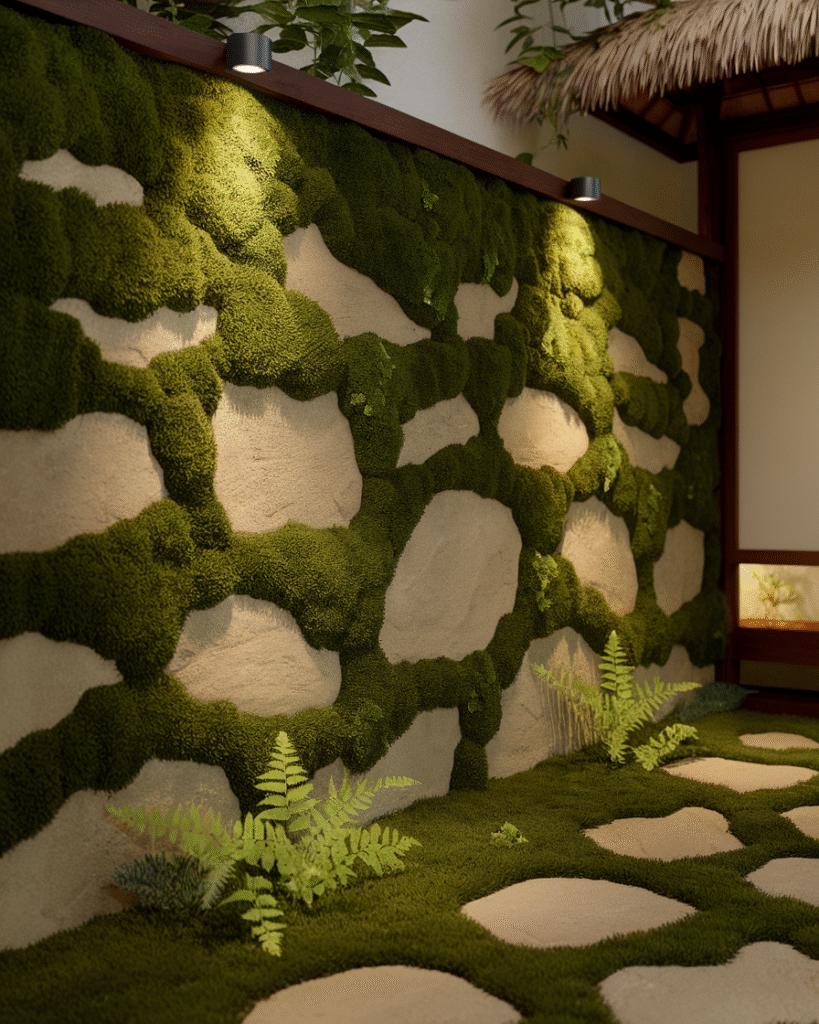
Conclusion Bringing DIY Outdoor Garden Walls Vertical Gardens to Life
Creating your own DIY outdoor garden walls vertical gardens is one of the most rewarding ways to transform your outdoor space without spending a fortune. You get beauty, texture, greenery, and personality all in one project. With the right plants, the right structure, and a design that matches your style, your outdoor area can become a private retreat where you relax, cook, entertain, or simply enjoy the fresh air. Start with one small wall, experiment with different plant combinations, and watch your space come alive with color and movement.
FAQs About DIY Outdoor Garden Walls Vertical Gardens
How often should I water a vertical garden wall
Most vertical gardens need watering every one to three days depending on sunlight and plant type. Warm climates may require more frequent watering, especially for shallow planters.
Which plants grow best on a vertical garden wall
Herbs, succulents, ferns, ivy, strawberries, cherry tomatoes, and compact flowers are excellent choices. Select plants based on sunlight and climate for the best results.
Do vertical garden walls damage outdoor walls
Not if installed correctly. Use a backing board or space the garden slightly away from the home wall. This prevents moisture buildup and protects the structure.
Can I build a vertical garden in a shaded area
Yes. Ferns, moss, hostas, and shade tolerant ivy varieties thrive in low light areas. Choose plants specifically labeled for shade.
Are vertical garden walls hard to maintain
With the right irrigation and plant selection, they are surprisingly easy to care for. Regular trimming and occasional replanting help keep the wall looking healthy and full.

